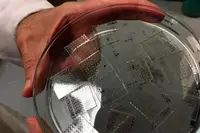 Researchers from the Georgia Institute of Technology have developed a capacitor dielectric material, using a hybrid silica sol-gel material and a nanoscale self-assembled monolayer of octylphosphonic acid, which is claimed to provide electrical energy storage capacity rivalling that of batteries.
Researchers from the Georgia Institute of Technology have developed a capacitor dielectric material, using a hybrid silica sol-gel material and a nanoscale self-assembled monolayer of octylphosphonic acid, which is claimed to provide electrical energy storage capacity rivalling that of batteries.
The bilayer structure blocks the injection of electrons into the sol-gel material, providing low leakage current, high breakdown strength and high energy extraction efficiency. Devices made from the material could surpass traditional electrolytic capacitors for applications in electromagnetic propulsion, electric vehicles and defibrillators.
"Sol-gels with organic groups are well known and fatty acids such as phosphonic acids are well known," said Joseph Perry, a professor in the School of Chemistry and Biochemistry at the Georgia Institute of Technology. "But to the best of our knowledge, this is the first time these two types of materials have been combined into high-density energy storage devices."
The need for efficient, high-performance materials for electrical energy storage has been growing along with the demand for electrical energy in mobile applications. Dielectric materials can provide fast charge and discharge response, high energy storage, and power conditioning for defence, medical and commercial applications. But, Prof Perry says it has been challenging to find a single dielectric material able to maximise permittivity, breakdown strength, energy density and energy extraction efficiency.
In their structures, the researchers demonstrated extractable energy densities up to 40J/cm3, an energy extraction efficiency of 72% at field strength of 830V/µm, and a power density of 520W/cm3. The performance is said to exceed that of conventional electrolytic capacitors and thin-film li-ion batteries, though it doesn't match the li-ion battery formats commonly used in electronic devices and vehicles.
"This is the first time I've seen a capacitor beat a battery on energy density," Prof Perry said. "The combination of high energy density and high power density is uncommon in the capacitor world."
The next step will be to scale up the materials to see if the properties transfer to larger devices. If that is successful, the material is expected to be commercialised through a start-up company or SBIR project.
Author
Tom Austin-Morgan
Source: www.newelectronics.co.uk
